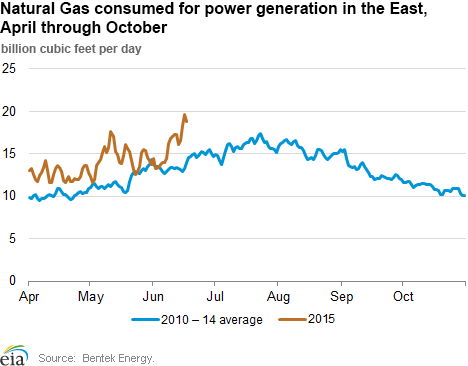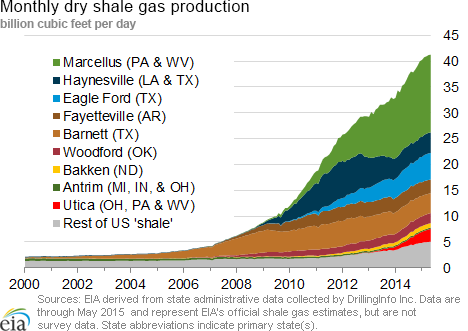In the News:
Eastern U.S. Power Burn Higher This Year
Natural gas consumption in the eastern half of the country, particularly in the electric power sector (power burn), has been much higher this spring than in previous years, according to Bentek Energy data. Both short-term weather-related factors and long-term structural changes in power markets led to the increase this year.
Temperatures in the past few months have been above average in the eastern United States. The Northeast, in particular, recorded its warmest May ever, according to data from the National Oceanic and Atmospheric Administration. Since May, temperatures in the Northeast averaged 68.4°, 1.8° warmer than the 2010–14 average, with periods of much warmer-than-normal temperatures in early May and this past week. Temperatures this week reached into the high 80s and 90s with high humidity across most of the East Coast. On Monday and Tuesday this week, temperatures in parts of the Northeast were more than 10° warmer than normal, according to the National Weather Service.
Retirements of coal-fired and nuclear power plants have also contributed to the increase in East Coast power burn. In 2015, 12.1 gigawatts (GW) of coal-fired capacity is expected to retire because of the implementation of the Environmental Protection Agency's Mercury and Air Toxics Standards. About 4 GW of coal-fired capacity retired in April, although on average this capacity was operating at a below-normal 25% capacity factor. An additional 32 coal plants, amounting to about 6 GW, are scheduled for retirement this month. Many of these are in Ohio, West Virginia, Kentucky, and Georgia.
The warmer weather and large increases in gas-fired generation this year may be contributing to increases in Northeast prices in particular. Although prices at Transcontinental Pipeline's (Transco) Zone 6 trading point for delivery to New York City have been lower this year than a year ago, they are closer to the Henry Hub national benchmark price. Between April 1 and June 16 last year, the Transco Zone 6 price averaged 82¢ below the Henry Hub spot price. For the same period this year, however, Transco Zone 6 prices have averaged only 23¢ less than the Henry Hub.
Overview:
(For the Week Ending Wednesday, June 17, 2015)
- Prices of natural gas at most market locations were mixed over the report week (Wednesday, June 3, through Wednesday, June 10). The Henry Hub spot price began the week at $2.92/million British thermal units (MMBtu) last Wednesday and ended the week at $2.93/MMBtu.
- At the New York Mercantile Exchange (Nymex), the July contract fell from $2.891/MMBtu to $2.855/MMBtu yesterday.
- Working natural gas in storage increased to 2,433 billion cubic feet (Bcf) as of Friday, June 12. A net injection into storage of 89 Bcf for the week resulted in storage 42.9% above a year ago and 1.9% above the five-year average for this week.
- The total oil and natural gas rig count fell by 9 units to 859 for the week ending Friday, June 12, according to data from Baker Hughes Incorporated. The oil rig count fell by 7 active rigs, to 635, continuing a decline of more than six months. The natural gas rig count fell by 1, and now totals 221. Miscellaneous rigs declined by 1, leaving 3 in operation.
- The natural gas plant liquids composite price at Mont Belvieu decreased by 4%, or 21¢, to $4.67/MMBtu for the week ending June 12. While natural gasoline and ethane spot prices rose by 1.0% and 2.3%, respectively, spot prices for propane, butane, and isobutane all decreased. Propane fell the most, a drop of 51¢, or 11.5%, followed by isobutane at 7.0% and butane at 5.3%. The Mont Belvieu composite price of $4.67/MMBtu is less than half of the $9.84/MMBtu composite reported out for the same week last year.
Prices/Demand/Supply:
Prices mixed because of maintenance outages and weather. Natural gas prices were mixed across spot market locations this report period. While above-average temperatures and storms affected some areas, others, like the Northeast, saw cooler weather at the start of the report week, causing demand and prices in the electric-power sector to fluctuate. The Henry Hub spot price began the week at $2.92/MMBtu, dropped slightly through the first half of the report week, but rebounded on Monday with the threat of Tropical Storm Bill making landfall on the Texas Gulf Coast, and closed the week yesterday at $2.93/MMBtu.
Northeast prices down, with Boston down $1. With temperatures moderating during the first half of the report week in the Northeast, and demand down, spot prices in the Northeast dropped through Friday. Transcontinental Zone 6, serving New York City, started the report week at $3.01/MMBtu, and dropped to $2.70/MMBtu on Friday. With hotter temperatures on Monday and Tuesday, prices increased. Prices at that location ended the week at $2.91/MMBtu. Similarly, in New England, the Algonquin Citygate and Tennessee Zone 6 200L, covering Boston and lower New England respectively, started the week above $3.10/MMBtu and dropped to near $1.50/MMBtu on Friday, before increasing on Monday and Tuesday to end the report week above $2.00/MMBtu. Despite this increase, Algonquin Citygate and Tennessee Zone 6 200L were both $1 below their prices last Wednesday, closing at $2.04/MMBtu and $2.06/MMBtu, respectively.
Marcellus prices fall through Friday. With milder weather at the start of the report week, Marcellus prices fell through Friday. Prices at Tennessee Zone 4 Marcellus last Wednesday averaged $1.26/MMBtu, and fell 55¢ (44%) by Friday to 71¢/MMBtu, before increasing to $1.22/MMBtu yesterday. Both the Transco-Leidy Line and Dominion South spot prices increased Wednesday to Wednesday, with prices at Transco-Leidy Line and Dominion South starting the report week at $1.27/MMBtu and $1.49/MMBtu, respectively, and both closing at $1.62/MMBtu yesterday.
Nymex prices rise. At the Nymex, the July contract began the week at $2.891/MMBtu and fell slightly to close at $2.855/MMBtu yesterday. The 12-month strip, which averages the July 2015 through June 2016 Nymex prices, closed at $3.086/MMBtu yesterday, down 3¢ from the week-ago price.
Supply and production remained flat this week. Dry gas production was down by 0.7% week over week, averaging 71.5 billion cubic feet per day (Bcf/d), according to Bentek Energy data, but was up 5.1% over the production for this week last year. Imports of natural gas from Canada fell by 0.2%, with receipts in the West and Midwest decreasing slightly from the previous week, and Northeast receipts decreasing 33.6%. Overall supply decreased by 0.6%. There were no reported effects on natural gas production from Tropical Storm Bill, which made landfall in Texas on Tuesday.
Demand continues to increase, led by power generation. Overall U.S. gas consumption increased by 3.4% this week, with an 8.2% increases in power-sector consumption offsetting a 1.9% decline in consumption in the industrial sector, and a generally flat residential/commercial sector. The increase in natural gas consumed in the power sector was driven by increases in consumption in the Northeast and Southeast. Those regions increased 21.1% and 13.8%, respectively. Power burn was down in the Midwest and Texas by 2.1% and 2.8%, likely due to milder temperatures.
Exports to Mexico increased to 3.1 Bcf/d on June 12, setting an all-time high, according to data from Bentek Energy, and remained at that level through Wednesday. Exports to Mexico increased 10% week over week, and are 40% more than exports for the same week last year.
Storage
Storage injection slightly higher than five-year average. The net injection reported for the week ending June 12 was 89 Bcf, down from 111 Bcf the previous week. This compares with the five-year average increase of 87 Bcf for the week and last year's increase of 112 Bcf. Working gas inventories for the storage week totaled 2,433 Bcf, 730 Bcf (42.9%) higher than last year at this time and 46 Bcf (1.9%) higher than the five-year (2010-14) average.
Storage injections were lower than market expectations. Market expectations, on average, called for a build of 93 Bcf. When the EIA storage report was released at 10:30 a.m. on June 18, the price for the July natural gas futures contract fluctuated modestly and eventually stabilized at $2.84/MMBtu in Nymex futures trading, very close to where prices were prior to the release.
From the week ending April 3 (the beginning of the injection season) through the week ending June 12, net storage injections totaled 972 Bcf, or 12% more than the 870 Bcf injected during the same 11 weeks in 2014. During these weeks for the years 2010 to 2014, net injection into storage averaged 736 Bcf. The estimated average unit value of the natural gas storage holders put into storage from April 3 to June 12 this year is $2.74/MMBtu, 40% lower than the average value of $4.60/MMBtu for the same 11 weeks last year. The highest winter-month Nymex price (for the January 2016 contract) in trading for the week ending June 12 averaged $3.28/MMBtu. This price is 48¢/MMBtu more than the July Nymex contract price. A year ago, the difference was 9¢/MMBtu, suggesting there is more financial incentive this year to buy and store natural gas in the summer for sale in the winter.
Temperatures during the storage report week warmer than normal. Temperatures in the Lower 48 states averaged 71.9° Fahrenheit for the storage report week, 3.0° warmer than the 30-year normal temperature and 1.7° warmer than the average temperature during the same week last year. There were 5 population-weighted heating degree days (HDD) during the storage report week, 5 HDD less than the five-year average and 4 HDD less than during the same period last year. There were also 53 population-weighted cooling degree days (CDD) this report week, 5 CDD more than the five-year average and 8 CDD more than during this week last year.
See also:
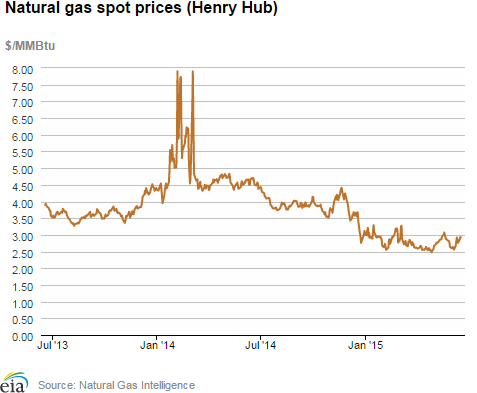
| Spot Prices ($/MMBtu) | Thu, 11-Jun |
Fri, 12-Jun |
Mon, 15-Jun |
Tue, 16-Jun |
Wed, 17-Jun |
|---|---|---|---|---|---|
| Henry Hub |
2.87 |
2.76 |
2.86 |
2.93 |
2.93 |
| New York |
2.95 |
2.70 |
3.01 |
3.03 |
2.91 |
| Chicago |
2.83 |
2.69 |
2.82 |
2.86 |
2.89 |
| Cal. Comp. Avg,* |
2.92 |
2.81 |
2.92 |
2.97 |
3.02 |
| Futures ($/MMBtu) | |||||
| July contract |
2.825 |
2.750 |
2.889 |
2.894 |
2.855 |
| August contract |
2.855 |
2.776 |
2.912 |
2.918 |
2.883 |
| *Avg. of NGI's reported prices for: Malin, PG&E citygate, and Southern California Border Avg. | |||||
| Source: NGI's Daily Gas Price Index | |||||
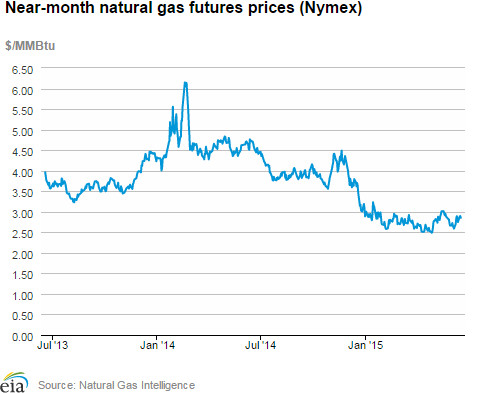
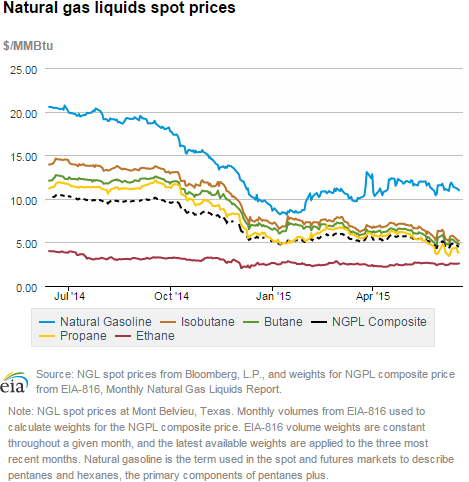
| U.S. natural gas supply - Gas Week: (6/10/15 - 6/17/15) | ||
|---|---|---|
Percent change for week compared with: |
||
last year |
last week |
|
| Gross production | 5.12%
|
-0.69%
|
| Dry production | 5.07%
|
-0.69%
|
| Canadian imports | 19.36%
|
-0.18%
|
| West (net) | 42.80%
|
-2.34%
|
| Midwest (net) | 16.81%
|
-0.94%
|
| Northeast (net) | -178.40%
|
-33.55%
|
| LNG imports | 8.18%
|
17.01%
|
| Total supply | 5.97%
|
-0.63%
|
| Source: BENTEK Energy LLC | ||
| U.S. consumption - Gas Week: (6/10/15 - 6/17/15) | ||
|---|---|---|
Percent change for week compared with: |
||
last year |
last week |
|
| U.S. consumption | 10.3%
|
3.4%
|
| Power | 30.7%
|
8.2%
|
| Industrial | -2.1%
|
-1.9%
|
| Residential/commercial | -7.0%
|
0.5%
|
| Total demand | 11.5%
|
3.7%
|
| Source: BENTEK Energy LLC | ||
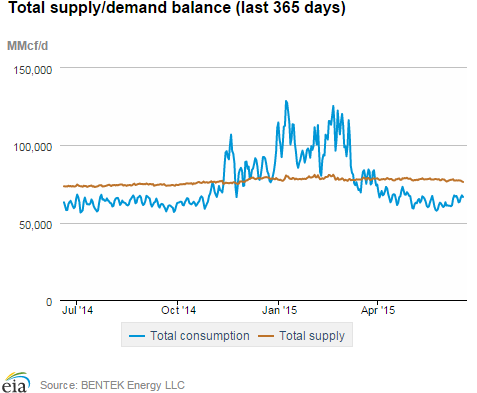
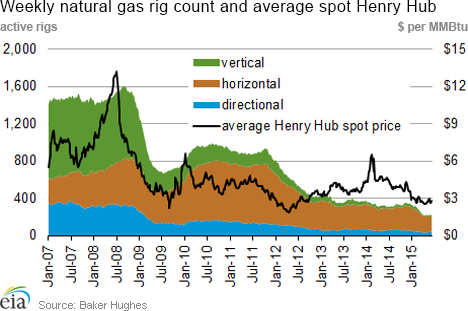
| Rigs | |||
|---|---|---|---|
Fri, June 12, 2015 |
Change from |
||
last week |
last year |
||
| Oil rigs | 635 |
-1.09% |
-58.82% |
| Natural gas rigs | 221 |
-0.45% |
-28.71% |
| Miscellaneous | 3 |
-25.00% |
50.00% |
| Rig numbers by type | |||
|---|---|---|---|
Fri, June 12, 2015 |
Change from |
||
last week |
last year |
||
| Vertical | 101 |
2.02% |
-73.97% |
| Horizontal | 663 |
-1.49% |
-46.88% |
| Directional | 95 |
-1.04% |
-56.42% |
| Source: Baker Hughes Inc. | |||
| Working gas in underground storage | ||||
|---|---|---|---|---|
Stocks billion cubic feet (bcf) |
||||
| Region | 2015-06-12 |
2015-06-05 |
change |
|
| East | 1,000 |
941 |
59 |
|
| West | 430 |
422 |
8 |
|
| Producing | 1,003 |
981 |
22 |
|
| Total | 2,433 |
2,344 |
89 |
|
| Source: U.S. Energy Information Administration | ||||
| Working gas in underground storage | |||||
|---|---|---|---|---|---|
Historical comparisons |
|||||
Year ago (6/12/14) |
5-year average (2010-2014) |
||||
| Region | Stocks (Bcf) |
% change |
Stocks (Bcf) |
% change |
|
| East | 780 |
28.2 |
1,102 |
-9.3 |
|
| West | 296 |
45.3 |
378 |
13.8 |
|
| Producing | 627 |
60.0 |
907 |
10.6 |
|
| Total | 1,703 |
42.9 |
2,387 |
1.9 |
|
| Source: U.S. Energy Information Administration | |||||
| Temperature -- heating & cooling degree days (week ending Jun 11) | ||||||||
|---|---|---|---|---|---|---|---|---|
HDD deviation from: |
CDD deviation from: |
|||||||
| Region | HDD Current |
normal |
last year |
CDD Current |
normal |
last year |
||
| New England | 22
|
0
|
9
|
13
|
5
|
1
|
||
| Middle Atlantic | 9
|
-5
|
4
|
24
|
5
|
10
|
||
| E N Central | 7
|
-11
|
-10
|
33
|
5
|
26
|
||
| W N Central | 3
|
-13
|
-12
|
59
|
23
|
36
|
||
| South Atlantic | 0
|
-4
|
0
|
76
|
10
|
-6
|
||
| E S Central | 0
|
-3
|
0
|
79
|
19
|
13
|
||
| W S Central | 0
|
0
|
0
|
109
|
18
|
12
|
||
| Mountain | 9
|
-20
|
-8
|
46
|
2
|
-11
|
||
| Pacific | 1
|
-19
|
-3
|
33
|
15
|
-4
|
||
| United States | 5
|
-10
|
-4
|
53
|
11
|
8
|
||
|
Note: HDD = heating degree-day; CDD = cooling degree-day Source: National Oceanic and Atmospheric Administration | ||||||||
Average temperature (°F)
7-Day Mean ending Jun 11, 2015
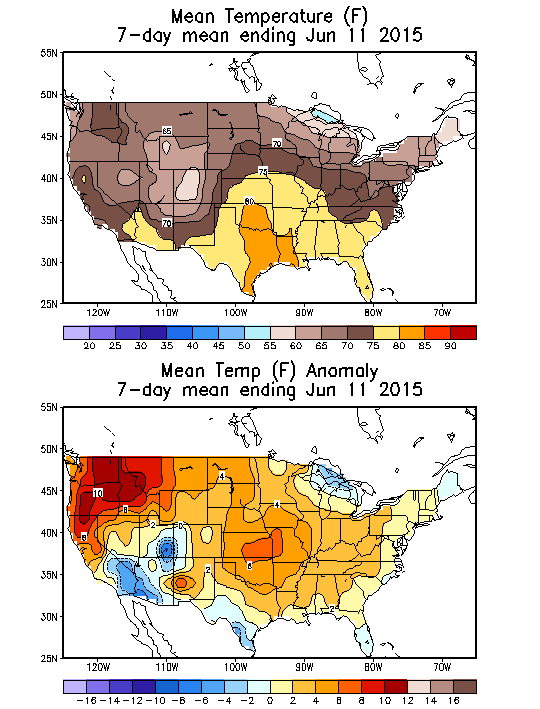
Source: NOAA/National Weather Service
Deviation between average and normal (°F)
7-Day Mean ending Jun 11, 2015

Source: NOAA/National Weather Service

